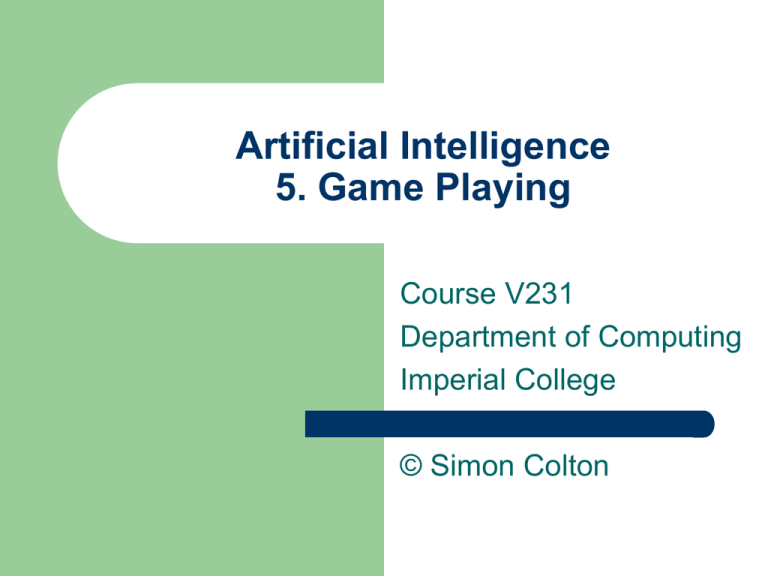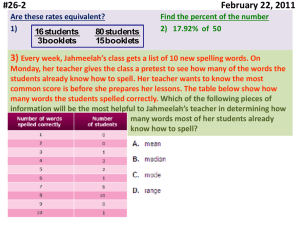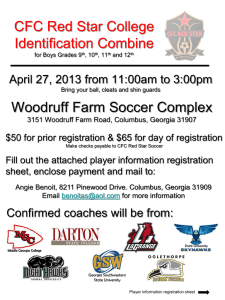slides
advertisement

Artificial Intelligence 5. Game Playing Course V231 Department of Computing Imperial College © Simon Colton Two Player Games Competitive rather than cooperative – Zero sum game – – One player loses, one player wins One player wins what the other one loses See game theory for the mathematics Getting an agent to play a game – – Boils down to how it plays each move Express this as a search problem Cannot backtrack once a move has been made (episodic) (Our) Basis of Game Playing: Search for best move every time Search for Opponent Move 1 Moves Initial Board State Board State 2 Search for Opponent Move 3 Moves Board State 4 Board State 3 Board State 5 Lookahead Search If I played this move – Then they might play that move Then I could do that move – – Or they might play that move Then I could do that move – And they would play that move Or I could play that move – And they would probably do that move And they would do that move If I played this move… Lookahead Search (best moves) If I played this move – Then their best move would be Then my best move would be – – Then their best move would be Or another good move for them is… Then my best move would be – Etc. Minimax Search Like children sharing a cake Underlying assumption – Each player moves in such a way as to – – Opponent acts rationally Maximise their final winnings, minimise their losses i.e., play the best move at the time Method: – Calculate the guaranteed final scores for each move – Assuming the opponent will try to minimise that score Choose move that maximises this guaranteed score Example Trivial Game Deal four playing cards out, face up Player 1 chooses one, player 2 chooses one – Player 1 chooses another, player 2 chooses another And the winner is…. – – Add the cards up The player with the highest even number Scores that amount (in pounds sterling from opponent) For Trivial Games Draw the entire search space Put the scores associated with each final board state at the ends of the paths Move the scores from the ends of the paths to the starts of the paths – – Whenever there is a choice use minimax assumption This guarantees the scores you can get Choose the path with the best score at the top – Take the first move on this path as the next move Entire Search Space Moving the scores from the bottom to the top Moving a score when there’s a choice Use minimax assumption – Rational choice for the player below the number you’re moving Choosing the best move For Real Games Search space is too large – So we cannot draw (search) the entire space For example: chess has branching factor of ~35 – – Suppose our agent searches 1000 board states per second And has a time limit of 150 seconds – This is only three or four ply look ahead – So can search 150,000 positions per move Because 353 = 42,875 and 354 = 1,500,625 Average humans can look ahead six-eight ply Cutoff Search Must use a heuristic search Use an evaluation function – Draw search space to a certain depth – Estimate the guaranteed score from a board state Depth chosen to limit the time taken Put the estimated values at the end of paths Propagate them to the top as before Question: – Is this a uniform path cost, greedy or A* search? Evaluation Functions Must be able to differentiate between – – – Good and bad board states Exact values not important Ideally, the function would return the true score For goal states Example in chess – – Weighted linear function Weights: Pawn=1, knight=bishop=3, rook=5, queen=9 Example Chess Score Black has: – 5 pawns, 1 bishop, 2 rooks Score = 1*(5)+3*(1)+5*(2) = 5+3+10 = 18 White has: – 5 pawns, 1 rook Score = 1*(5)+5*(1) = 5 + 5 = 10 Overall scores for this board state: black = 18-10 = 8 white = 10-18 = -8 Evaluation Function for our Game Evaluation after the first move – Count zero if it’s odd, take the number if its even Evaluation function here would choose 10 – But this would be disastrous for the player Problems with Evaluation Functions Horizon problem – Agent cannot see far enough into search space Possible solution – Reduce the number of initial moves to look at Potentially disastrous board position after seemingly good one Allows you to look further into the search space Non-quiescent search – – – Exhibits big swings in the evaluation function E.g., when taking pieces in chess Solution: advance search past non-quiescent part Pruning Want to visit as many board states as possible – Want to avoid whole branches (prune them) – Example: having your queen taken in chess Because they can’t possibly lead to a good score (Queen sacrifices often very good tactic, though) Alpha-beta pruning – – Can be used for entire search or cutoff search Recognize that a branch cannot produce better score Than a node you have already evaluated Alpha-Beta Pruning for Player 1 1. Given a node N which can be chosen by player one, then if there is another node, X, along any path, such that (a) X can be chosen by player two (b) X is on a higher level than N and (c) X has been shown to guarantee a worse score for player one than N, then the parent of N can be pruned. 2. Given a node N which can be chosen by player two, then if there is a node X along any path such that (a) player one can choose X (b) X is on a higher level than N and (c) X has been shown to guarantee a better score for player one than N, then the parent of N can be pruned. Example of Alpha-Beta Pruning player 1 player 2 Depth first search a good idea here – See notes for explanation Games with Chance Many more interesting games – – Example: backgammon – Have an element of chance Brought in by throwing a die, tossing a coin See Gerry Tesauro’s TD-Gammon program In these cases – – We can no longer calculate guaranteed scores We can only calculate expected scores Using probability to guide us Expectimax Search Going to draw tree and move values as before Whenever there is a random event – – Work out all possible board states from chance node When moving score values up through a chance node – Add an extra node for each possible outcome which will change the board states possible after the event E.g., six extra nodes if each roll of die affects state Multiply the value by the probability of the event happening Add together all the multiplicands – Gives you expected value coming through the chance node More interesting (but still trivial) game Deal four cards face up Player 1 chooses a card Player 2 throws a die – – If it’s a six, player 2 chooses a card, swaps it with player 1’s and keeps player 1’s card If it’s not a six, player 2 just chooses a card Player 1 chooses next card Player 2 takes the last card Expectimax Diagram Expectimax Calculations Games Played by Computer Games played perfectly: – – Connect four, noughts & crosses (tic-tac-toe) Best move pre-calculated for each board state Games played well: – – Small number of possible board states Chess, draughts (checkers), backgammon Scrabble, tetris (using ANNs) Games played badly: – Go, bridge, soccer Philosophical Questions Q1. Is how computers plays chess – In science, simple & effective techniques are valued – – Minimax cutoff search is simple and effective But this is seen by some as stupid and “non-AI” Drew McDermott: – More fundamental than how people play chess? "Saying Deep Blue doesn't really think about chess is like saying an airplane doesn't really fly because it doesn't flap its wings” Q2. If aliens came to Earth and challenged us to chess… – Would you send Deep Blue or Kasparov into battle?






